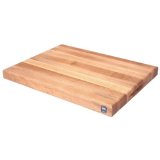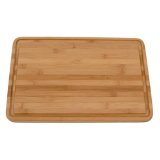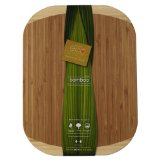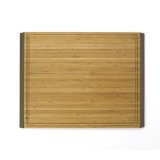What is the Best Bamboo Cutting Board?
Very much like buying kitchen knives choosing the right cutting board can be a confusing task and is often a challenge for many; do you want a Bamboo cutting board, Wood, or Plastic cutting board? But don’t worry we’ve got you covered, in this article we are going to focus on the best Bamboo cutting boards.
Bamboo has become a popular material to use for manufacturing cutting boards in the last few years due to advancements in technology. Bamboo cutting boards are also a favorite with environmentalist due to it being a hard grass that is easily sustainable and this renewable resource requires no chemicals to grow or to be harvested.
Professional and home cooks alike are now choosing Bamboo cutting boards over any other type and this style of chopping board are now some of the best selling for everyday use. If you don’t already own a Bamboo cutting board what are you waiting for?
Bamboo Cutting Board Buying Guide
Benefits of Using Bamboo Cutting Boards?
Bamboo boards have many more benefits over your regular wood cutting board and often you’ll find that they are a lot cheaper and offer up more bang for your buck!
Below are some of the main benefits of using the bamboo variety:
Water Retention: unlike regular wooden cutting boards Bamboo bards are not very porous meaning that they don’t retain water as easily as wooden cutting boards. What are the big problems with having a porous cutting board is that eventually they will warp and crack this is far less likely to happen with Bamboo cutting boards. Many also believe they are more sanitary compared to wood boards because food juice and blood from meat is not being absorbed onto the board. Which in-turn will help protect against common bacteria, such as E. Coli or Salmonella.
Durable: even though Bamboo is considered a type of grass it is extremely durable and strong which makes is a desirable material to use as a cutting board. The durability of this type of cutting board makes it aesthetically appealing as your knives don’t leave a mark on the cutting board easily. However some have stated that the Bamboo cutting boards or to touch and may in fact dull your kitchen knives – this is still an on-going debate and there is no evidence that Bamboo boards damages your knives.
Renewable: as I mentioned at the beginning of this article, properly sourced Bamboo is a renewable source and only takes around 3 – 6 years to fully grow, whereas wood can take up to 30 years before it can be harvested.
Its quick growth enables bamboo to be affordably harvested, and is often grown organically due to the ease of farming.
Bamboo Looks Good: and lastly Bamboo cutting boards look great, the light wood along with the fine grain looks great in any modern kitchen and you’ll find that many of today’s chefs love the natural look of Bamboo and the modern elegance that it brings to the kitchen.
And also another plus, you don’t have to worry about your cutting boards becoming scared by repeated use of your kitchen knife meaning your Bamboo cutting board will look great for many years.
Bamboo Cutting Board Basic Care and Maintenance
Oil The Board: When you first unwrap your new Bamboo cutting board it’s very important to prep the board before your first use, what you do now will determine the health and longevity of your board. Don’t worry it’s not too difficult. When you buy your cutting board make sure you also pick up some mineral oil or board cream, simply drizzle some of the oil or cream onto the Bamboo board and rub it in with a soft, dry cloth.
The mineral oil helps to moisturize the board which will help reduce the chance of your board splitting and also it gives your cutting board a lovely shine. Simply repeat this process every day for about a week, and then just routinely treat your cutting board once a month thereafter.
Cleaning: make sure you wash your Bamboo boards by hand in warm soapy water after every use. Do not leave your board floating in the kitchen sink, this is a big NO. Ideally you should dry your board after you have washed it or simply just leave it standing up-right in your dish rack to air dry.
If you use your cutting board for prepping fresh meat, it’s wise to disinfect them after each use. Don’t worry this is easier than you think, just dissolve one part vinegar in five parts water, and use a sponge to scrub down the board, rinse as mentioned above and dry.
Tip: it is best to have one board for each kitchen prepping task, for example; one board for raw meat, one for fruits & vegetables, one for cooked food, one for dairy products, one for fish & seafood, and one for raw poultry.
This is probably not viable for the home kitchen, 2 cutting boards is just fine; 1 for raw meats and 1 for fruits and vegetables – just make sure you clean them well after each use.
Removing Stains: after repeated use you may notice that your cutting board is becoming stained; this is not a health hazard so don’t worry but it can ruin the look of the bamboo board. But don’t fret just yet getting rid of the stains on your Bamboo cutting board is pretty easy.
Simply take some coarse salt and rub in over you cutting board either with your hands, a cloth or sponge, then just rinse and dry as normal. If you have stubborn stains just repeat the process.
Removing Odors: like wooden cutting board odors can attach themselves to Bamboo boards. To remove odors from your cutting board try rubbing a thick paste (water and Baking Soda mixed) of Baking Soda over the board before rinsing and drying.
Tip: When shopping for new bamboo cutting boards make sure you buy a board that has not made with formaldehyde glues. Bamboo cutting boards made by Totally Bamboo or Bambu use safe formaldehyde-free glues in their manufacturing process.
>> See reviews, prices, and offers on Bamboo Cutting boards at Amazon <<










